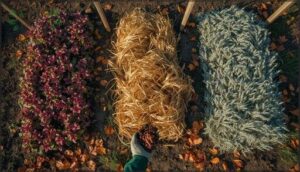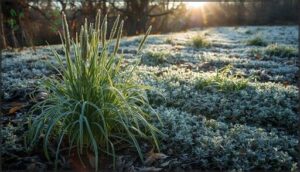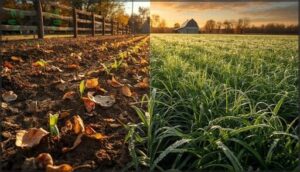This site is supported by our readers. We may earn a commission, at no cost to you, if you purchase through links.
Your soil loses more than you think each winter—organic matter breaks down, nitrogen leaches away, and bare ground invites erosion that can strip away years of careful stewardship.
Fall cover crops interrupt this decline, transforming dormant months into active soil-building time. They fix atmospheric nitrogen, boost microbial biomass by up to 60%, and reduce erosion by as much as 95% while you’re planning next season.
Choosing the best fall cover crops for healthy soil means matching specific species to your climate, goals, and soil conditions—whether you need cold-hardy winter rye, nitrogen-rich crimson clover, or fast-establishing oats that protect vulnerable ground before the first freeze.
Table Of Contents
- Key Takeaways
- Why Plant Fall Cover Crops?
- Choosing The Right Fall Cover Crop
- Nitrogen-Fixing Fall Cover Crops
- Cold-Hardy Fall Cover Crops
- Fast-Growing Fall Cover Crops
- Cover Crops for Soil Structure
- Planting and Managing Fall Cover Crops
- Maximizing Benefits of Fall Cover Crops
- Frequently Asked Questions (FAQs)
- What is the best cover crop to plant in fall?
- What are the best cover crops for soil health?
- What is the best fall crop to grow?
- What is the king of cover crops?
- What is the best cover crop to improve soil?
- What is one crop that can replenish soil?
- What is fall cover cropping?
- What is a good fall cover crop?
- Are fall-seeded cover crops right for You?
- What are cover crops?
- Conclusion
Key Takeaways
- Fall cover crops deliver measurable soil improvements in a single season—boosting organic carbon by 1.2–2.5%, increasing microbial biomass up to 60%, and reducing erosion by 30–95% depending on species and slope.
- Nitrogen-fixing legumes like hairy vetch and crimson clover contribute 60–180 kg of nitrogen per hectare annually, cutting synthetic fertilizer needs by 20–40% while suppressing weeds by 40–70%.
- Cold-hardy varieties such as winter rye tolerate temperatures down to -20°F and establish protective ground cover when soil temperatures drop to just 34°F, making them ideal for harsh-winter regions.
- Strategic timing matters most—planting between late August and mid-October in temperate zones ensures establishment before frost, while terminating 2–4 weeks before spring planting maximizes nutrient release without delaying soil warming.
Why Plant Fall Cover Crops?
When you let your soil rest bare over winter, you’re missing out on one of the most powerful tools for building long-term fertility and structure. Fall cover crops work while your garden sleeps, protecting what you’ve built during the growing season and setting the stage for healthier plants come spring.
Here’s why planting a cover crop this fall makes sense for your soil and your future harvests.
Soil Health Improvement
Your soil’s vitality transforms when you plant fall cover crops. These living blankets boost soil organic carbon by 1.2–2.5% in just one season while increasing microbial biomass by up to 60%. Nitrogen-fixing legumes add 15–35 kg N/ha, fueling nutrient cycling. You’ll also see aggregate stability improve by 8–22%, strengthening soil structure.
This isn’t just conservation—it’s carbon sequestration that builds long-term soil health and resilience. Effective systematic review methods are vital for understanding the impact of cover crops on soil health.
Erosion and Runoff Prevention
Beyond building vitality, your fall cover crops act as guardians against soil loss. Ground cover reduces soil erosion by 30–95%, depending on species and slope. You’ll see runoff volume drop by 20–50% during winter storms as roots improve water infiltration. The benefits are clear:
- Tall, fast-growing species protect slopes over 5% most effectively
- Cover crops lower nutrient runoff losses by 40–60%
- Root systems increase infiltration rates by 15–35%
This erosion control safeguards your investment in soil health. Understanding the universal thematic principle is key to creating a cohesive narrative about soil conservation.
Weed and Pest Suppression
Your fall cover crops also double as a natural weed barrier and pest control method, fitting perfectly into organic farming and crop rotation systems.
Nitrogen-fixing legumes like crimson clover cut herbicide-tolerant weed biomass by 28%, while hairy vetch knocks down winter annuals by 35%.
You’ll also see a 33–41% boost in beneficial insects—hoverflies and predatory mites—that patrol your beds, reducing pest pressure naturally.
Organic Matter Addition
When you incorporate cover crops each autumn, you’re building your soil’s long-term fertility. Trials show organic carbon increases by 5.2–7.6% after just one growing season, while legumes boost organic matter by 0.3–0.8 percentage points within twelve months. This humus formation drives microbial activity and nutrient cycling.
Here’s what organic amendments from fall covers deliver:
- Carbon-rich residues from rye and wheat decompose slowly, protecting your soil surface while feeding beneficial organisms.
- Legume biomass breaks down faster—releasing 40–60% of total nitrogen within ninety days—fueling spring crops naturally.
- Aggregate stability improves by 8–28%, reducing compaction and boosting soil structure for healthier root zones.
Choosing The Right Fall Cover Crop
Selecting the right fall cover crop isn’t about guessing—it’s about matching what you plant to what your soil actually needs and what your garden can support. You’ll want to factor in three key factors: your soil’s current condition, your local climate and hardiness zone, and the specific goals you’re working toward this season.
Let’s walk through each consideration so you can make a choice that sets your soil up for long-term success.
Assessing Soil Needs
Understanding your land’s unique challenges starts with soil testing—it’s like getting a health checkup before prescribing treatment. Test results reveal nutrient levels and pH that predict nitrogen-fixing potential, guiding choices for soil improvement.
You’ll find that compaction reduction and organic matter gains improve by 0.3–0.8 percentage points after two seasons. Target erosion control where slopes shed water, and address soil fertility gaps for lasting soil health benefits.
Matching Crops to Climate
Climate zones shape which cover crops will thrive when temperatures drop. Match varieties to your frost tolerance needs: winter rye endures subzero conditions down to -20°F, while crimson clover prefers milder 45–70°F soil temperature ranges.
Regional adaptation matters—you’ll see better soil health outcomes when you consider these proven pairings:
- Northern climates: Winter rye and winter wheat for reliable erosion control
- Mild-winter regions: Crimson clover with balanced heat resistance
- Variable-weather zones: Vetch-rye blends for nitrogen and structure
Aligning With Garden Goals
Your cover crop strategy starts with clear goal setting. Nearly two-thirds of gardeners adjust their fall selections based on spring soil improvement targets—whether you’re boosting organic matter or fighting compaction.
Track soil metrics like aggregate stability to measure progress. Consider nitrogen availability for crop rotation planning, and time termination dates around garden planning needs.
This objective alignment transforms cover crops from soil amendments into strategic tools for sustainable gardening and long-term garden soil health.
Nitrogen-Fixing Fall Cover Crops
Nitrogen-fixing cover crops work like natural fertilizer factories, pulling nitrogen from the air and storing it in your soil for next season’s plants. Legumes excel at this process, building soil fertility while protecting it through the winter months.
Let’s look at four nitrogen-fixing options that perform well in fall plantings.
Crimson Clover Benefits
You’ll want crimson clover if nitrogen fixation is your priority—this fast-growing legume delivers 60–120 kg of nitrogen per hectare each year while adding up to 1.5 percentage points of organic matter within two seasons.
Its dense canopy cuts erosion by 40–60% on slopes and suppresses annual weeds by 20–50%, making it a triple-threat cover crop for soil health, weed control, and soil enrichment.
Hairy Vetch Advantages
Hairy vetch stands as the nitrogen-fixing powerhouse of fall cover crops, delivering 120–180 kg of nitrogen per hectare—often cutting your synthetic fertilizer needs by 20–40% in the next crop rotation. This champion also improves soil fertility while tackling soil erosion and weed suppression with impressive efficiency.
Here’s what makes hairy vetch outstanding for soil improvement techniques:
- Ground cover arrives fast: You’ll see coverage within 4–6 weeks, protecting slopes from erosion all winter long.
- Biomass builds organic matter: Expect 6–12 tons of dry matter per hectare, enriching your soil when you terminate it properly.
- Erosion drops dramatically: Soil loss decreases by 60–80% compared to bare ground on vulnerable fields.
- Weeds don’t stand a chance: Dense stands reduce weed emergence by up to 70% in your following cash crop.
- Water retention improves: Vetch residues boost soil moisture holding capacity by 5–15%, helping you through dry spells.
Terminate hairy vetch 4–8 weeks before planting your next crop—this timing releases nitrogen when your plants need it most while preventing residue problems. Pair it with cereal rye for even better cover crop benefits: you’ll get quick ground cover while vetch fixes atmospheric nitrogen deep in your soil profile.
Red Clover Characteristics
Red clover benefits your garden with deep roots reaching 4 feet, aerating compacted soil while fixing 100–150 pounds of nitrogen per acre annually—boosting soil fertility for your next crop rotation.
This nitrogen-fixing powerhouse thrives in pH 6.0–7.0 soils and survives winters down to -20°F, making it ideal for cover crops that improve soil health across multiple growing seasons.
Berseem Clover Uses
If you’re looking for rapid biomass production during fall planting, Berseem clover delivers impressive nitrogen-fixing performance—contributing 60–120 kg N ha⁻¹ that enriches soil nitrogen and feeds soil microbes throughout your crop rotation.
This cover crops champion suppresses weeds by 40–70% while building organic matter, making it valuable for sustainable agriculture focused on long-term soil health and clover benefits.
Cold-Hardy Fall Cover Crops
When temperatures drop and frost threatens, not all cover crops can handle the pressure. That’s where cold-hardy varieties step up, pushing through freezing conditions while continuing their work of protecting and enriching your soil.
Let’s look at three standouts that won’t quit when winter arrives.
Winter Rye Resilience
Winter Rye stands as a champion among cover crops for cold-climate gardens. You can plant it knowing it’ll germinate when soil temperatures drop to just 34°F, establishing protective ground cover within weeks.
Its frost tolerance and winter hardiness mean your soil stays protected through harsh weather, while its deep root depth addresses soil compaction and erosion prevention.
The rye soil benefits extend beyond winter, as decomposing residue enriches soil health season after season.
Winter Wheat Adaptability
Just as resilient, winter wheat brings outstanding adaptability to your fall cover crop lineup. You’ll find it establishes successfully across USDA zones 3–9 when soil temperatures reach 40–50°F. Its frost tolerance and winter hardiness protect your ground through cold months, while dense canopies suppress weeds by up to 70%.
Consider these soil health advantages:
- Reduces erosion through extensive root systems
- Improves infiltration rates by 15–40%
- Increases soil organic matter over multi-year crop rotations
Barley Cold Tolerance
Barley stands out for its exceptional frost survival, tolerating temperatures down to -15 to -20°C once established. Improved winter hardiness comes through cold acclimation when you provide 4–6 weeks of fall growth before hard frost—boosting stand establishment by 25%.
Vernalization effects boost barley regrowth after mild winters, maintaining forage quality and soil health benefits that support sustainable crop rotation in your winter gardening strategy.
Fast-Growing Fall Cover Crops
When you’re working against a short fall window, speed matters. Fast-growing cover crops establish quickly, giving you ground coverage and soil protection before the first hard freeze arrives.
Let’s look at three options that deliver rapid results when time is tight.
Oats for Quick Coverage
When you need fast results, oats deliver like few other cover crops can. These workhorses establish quickly in fall conditions, offering impressive benefits:
- Rapid germination within 5–7 days in cool, moist soil
- Abundant biomass production reaching 2–4 tons per acre before winter kill
- Excellent soil erosion control through dense root networks
- Enhanced soil health by adding organic matter
- Easy fall planting between September and early October
Their quick coverage benefits make oats perfect for short-window crop rotation strategies.
Berseem Clover Growth Rate
Berseem clover stands out among nitrogen-fixing cover crops due to its lightning-fast establishment. Germination typically occurs within 10–14 days, with plants quickly reaching 3 inches in height. Under ideal conditions, this legume achieves full ground cover in just 4–6 weeks—often 2–3 weeks faster than crimson clover or red clover.
| Growth Metric | Timeline | Ideal Condition |
|---|---|---|
| Germination Speed | 10–14 days | Soil temp 42°F+ |
| Full Ground Cover | 4–6 weeks | 15–25°C range |
| Biomass Production | 2,000 lbs/acre | Adequate moisture |
| Height Development | 3 inches | 10–14 days |
| Nitrogen Fixation | Active by Week 4–6 | pH 6.0–7.0 |
During peak growth, berseem clover accumulates 35–50 pounds of biomass per acre weekly. This rapid growth enhances soil health through active nitrogen fixation and the addition of organic matter.
Crimson Clover Speed
Crimson clover earns its reputation as a nitrogen-fixing champion through impressive growth patterns and seed germination rates. You’ll see floral development begin 45–70 days after sowing, with biomass accumulation reaching 2.1–3.5 tons per hectare during autumn.
This legume delivers 8–12 kg of nitrogen per hectare to boost soil health, establishing ground cover 35–55% faster than winter rye in those critical first weeks.
Cover Crops for Soil Structure
When you’re building healthier soil, structure matters just as much as nutrients. The right fall cover crops work beneath the surface, breaking up compacted layers and creating space for air, water, and roots to move freely.
Let’s look at three key ways cover crops transform your soil’s physical foundation.
Reducing Soil Compaction
Heavy traffic and wet conditions can leave your soil hard and inhospitable, but fall cover crops offer a powerful remedy.
Dense root networks from species like winter rye penetrate compacted layers, creating channels that improve drainage and reduce bulk density by 0.02–0.05 g cm⁻³.
You’ll see aggregate stability increase by 10–20%, transforming tight soil into a structure that fosters healthy root growth and nutrient flow.
Increasing Soil Porosity
Fall cover crops do more than break up compacted layers—they engineer a three-dimensional network of air spaces that transforms soil health. When you plant winter rye and hairy vetch mixtures, you’re investing in lasting soil aeration: late-fall sowing can boost macroporosity by 18% and water infiltration rates by up to 40%.
These hollow-fiber root channels improve porosity tests, support deeper root depth, and create stable structures that persist years beyond termination, making your soil conservation efforts pay dividends.
Boosting Organic Matter
Think of your soil as a living bank account—organic matter is the currency that funds long-term soil health.
Treat your soil like a living bank account—organic matter is the currency that funds long-term health
When you incorporate nitrogen-fixing cover crops like crimson clover or hairy vetch, you’re making deposits that matter: these legumes add 2.5–6 tons of biomass per hectare, raising soil carbon by 0.2–0.6% annually.
This organic amendment accelerates matter cycling, fuels microbe growth, and strengthens nutrient uptake for seasons to come.
Planting and Managing Fall Cover Crops
Successfully growing fall cover crops comes down to timing, technique, and knowing when to let them rest or cut them back. You’ll want to match your planting schedule to your local climate and soil conditions, then follow through with the right seeding depth and moisture management.
In this section, we’ll walk through when to plant, how to establish your cover crops, and what to do with them as winter approaches and spring returns.
Ideal Planting Times
Timing matters more than most gardeners realize when you’re working fall cover crops into your crop rotation. You’ll want to align your fall sowing with your climate zones and soil temperature—usually between late August and mid-October in temperate regions—to boost soil health benefits before winter dormancy sets in.
Key planting windows for fall gardening tips:
- Early fall (late August–September): Plant when soil temperature stays around 50–60°F for quick germination of species like crimson clover and winter wheat.
- Mid-fall (September–October): Focus your seedbed prep and sowing during this window to guarantee establishment before the first frost.
- Late fall (October–early November): In milder zones, extend planting windows for hardy species that tolerate cooler conditions.
Seeding and Watering Methods
Once you’ve planted at the right time, proper seed depth and watering make all the difference. Aim for 0.5–1 inch deep depending on seed size—precision seeders boost germination by 25–30% compared to broadcasting.
Keep soil moisture consistent with drip irrigation, which uses 70% less water than flood methods. Apply 2–3 inches of mulch to retain 50% more moisture and support healthier cover crops.
Overwintering and Termination
Your cover crops need the right send-off to benefit soil health. Overwintering species like winter rye maintain 60–90% of their stand after light freezes, while winter kill options die back naturally.
Termination timing matters—aim for 2–4 weeks before planting to reduce residue management issues and avoid delaying soil temperature warming. Frost injury drops 40% when crops establish strong canopies by November.
Maximizing Benefits of Fall Cover Crops
You’ve planted your fall cover crops—now it’s time to make them work even harder for you. Getting the most from your cover crops means thinking beyond a single season and considering how they fit into your overall land management strategy.
Let’s explore three practical ways to optimize the benefits these crops deliver to your soil, your wallet, and the ecosystem around you.
Integrating Cover Crops in Rotations
You’ll optimize your soil health when you blend cover crop diversity into thoughtful crop rotation strategies. Alternating nitrogen-fixing legumes with deep-rooted grasses aids soil microbe management and ecosystem services optimization.
Your rotation planning tools should track which covers follow which cash crops—this builds organic matter while preventing pest cycles. Smart crop selection means each cover plays a specific role in your soil conservation system.
Economic and Environmental Impact
Your investment in fall cover crops delivers dual rewards: cost savings and environmental stewardship working hand in hand. By cutting fertilizer needs 15–40% and slashing erosion up to 90%, you’re proving the economic viability of sustainable farming while protecting watersheds.
Government cost-share programs often cover 20–50% of establishment expenses, making these sustainable practices financially accessible as you build long-term soil health and environmental conservation into every season.
Supporting Beneficial Insects
Strategically chosen cover crops improve ecosystem services by creating pollinator habitat and supporting insect conservation throughout fall and winter. Nitrogen fixing legumes excel at attracting beneficial insects that safeguard soil health and soil biodiversity:
- Crimson clover boosts pollinator visitation 15–35% in adjacent crops
- Hairy vetch residues reduce foliar pest populations by 12%
- Red clover intercropping decreases aphid densities 9–14%
These cover crops strengthen beneficial microbes while extending natural enemy activity windows by 3–6 weeks.
Frequently Asked Questions (FAQs)
What is the best cover crop to plant in fall?
Winter rye survives temperatures down to -20°C and establishes rapidly, making it an excellent choice for most fall gardens.
However, your best crop depends on specific soil needs—nitrogen fixation, erosion control, or weed suppression.
What are the best cover crops for soil health?
You’ll want cover crops that boost soil microbes, improve nutrient cycling, and prevent erosion.
Legumes excel at nitrogen fixation for soil regeneration, while cereals add organic matter—crop diversity strengthens overall soil health and conservation.
What is the best fall crop to grow?
Your garden’s success starts with smart crop selection. Winter rye dominates for erosion control, while hairy vetch and crimson clover fix nitrogen. Mix oats with annual ryegrass for quick coverage and balanced soil preparation.
What is the king of cover crops?
Hairy vetch earns the title of king of cover crops through remarkable nitrogen fixation—delivering up to 200 kg N per hectare annually.
This legume powerhouse bolsters sustainable farming while improving soil health and reducing synthetic fertilizer dependency.
What is the best cover crop to improve soil?
Like a Swiss Army knife for your soil, cover crop mixes deliver multiple benefits—nitrogen fixation from legumes, erosion control from grasses, and boosted soil microbes.
Soil testing guides which combinations work best for your specific needs.
What is one crop that can replenish soil?
Crimson clover stands out as a nitrogen-fixing powerhouse that replenishes soil by adding 60–120 kg N/ha while boosting organic matter. You’ll find it improves soil health naturally without synthetic fertilizers.
What is fall cover cropping?
Think of it as nature’s blanket—fall cover cropping means planting crops in autumn specifically for soil protection and improvement, not harvest.
These fall planting choices establish roots that anchor soil, preventing erosion while building organic matter for spring.
What is a good fall cover crop?
Your crop selection depends on your soil needs. Crimson clover and hairy vetch fix nitrogen, while winter rye controls erosion.
Oats offer quick coverage, and oilseed radish breaks up compacted layers beautifully.
Are fall-seeded cover crops right for You?
Fall planting cover crops suits most gardens facing soil erosion or nutrient loss. Regional studies show 68% of gardeners with erosion problems adopt this practice.
Soil testing and garden planning help determine if cover crops match your soil conservation goals.
What are cover crops?
You plant cover crops not for harvest, but to protect and enrich your soil.
These workhorses of sustainable methods tackle erosion control, nitrogen fixation, and weed suppression while building healthier ground for future crop selection.
Conclusion
A single season of bare soil can undo years of careful amendments, but the best fall cover crops for healthy soil work tirelessly through winter’s harshest months.
You’re not just planting seeds—you’re deploying living infrastructure that captures nitrogen, anchors topsoil, and feeds billions of soil organisms while you wait for spring.
Choose strategically, plant timely, and watch dormant months become your most productive soil-building window yet.













